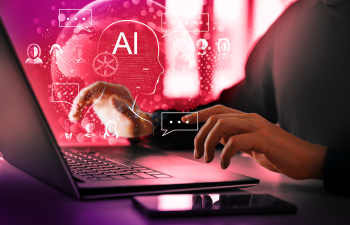
Written By: Jeff Harris, Vice President, Keysight Technologies
Some people see Artificial Intelligence (AI) as a panacea: a solution to every problem. This view can generate confusion about how to best deploy this technology.
One area where AI is proving its value is the transformation of product development across industries. With the pressure to accelerate the pace of design, this game-changing can play a transformational role. However, integrating it is not enough; engineers must also understand how to optimise the potential.
Every AI algorithm possesses three essential elements: the ability to measure, knowledge regarding how much of what you measure needs to be processed, and the ability to process more than one input at a time. 
In order to optimise your algorithm, you need to orchestrate the data. So, let’s delve into this and explore what this requires.
The Data Decision
In our complex and interconnected world, there is no shortage of information; however, it is not a practice to assume you can analyse everything. Outside of data centres where exchanges are unconstrained, decisions about what data is of high value become very important. To deliver on the promise of the AI algorithm, there is a balancing decision to be made around the best data set. This requires homing in on the following areas:
What Data Is Most Relevant to the Decision the AI Algorithm Is Making?
This requires understanding the data that is additive and stripping out information that doesn’t directly impact the decision the AI is trying to make.
How Much Data to Send?
It is crucial to understand how much information to send. A good rule to follow is focusing on the minimum data required to maximise the output of the AI algorithm.
The Communications Channel
It is important to then check that there is enough capacity to transmit the data from the sensor back to the algorithm in a timely manner. You can cherry-pick the relevant data, but if you cannot communicate it in the correct timeframe, the AI will fail to reach its potential.
Orchestrating the Data Is Vital to Maximise the Impact
This requires sifting through the information to identify the critical elements and ensuring that the communication channels can relay the information in the required time period. Before integrating AI, engineers must measure the communications channel’s bandwidth, latency, and reliability to ensure it matches what the AI algorithm needs.
Real-World Applications in Product Development
Examples of the data decision in action include the following:
IoT Device
Think of a smart light switch that is tasked with determining when to turn lights off and on. To achieve this, the sensor must be able to measure solar levels to understand when sunlight occurs and make a local decision to turn the light switch off or on as a result.
This requires the IoT device to have the processor capability to know a measurement came in, understand that the value was above zero and – because the value was above zero from the sensor input—automatically make the decision to turn the switch off
Autonomous Vehicle
An exponentially more complex example of delivering on the promise of AI is an autonomous vehicle (AV). Every AV is a web of inputs, including radars, sensors, LIDAR, and cameras, all focused on delivering a safe driving experience. However, the importance of each input changes as the environment evolves.
Think about a car driving in mountainous terrain versus the streets of Manhattan—the importance of the various inputs would differ significantly in these two locations.
For example, visual object recognition is critical to ensuring safe driving until it snows, at which point another input is more important. It is the role of the AI algorithm to determine at any given moment which inputs to emphasize when deciding whether the vehicle should continue to go forward at its current speed or make an adjustment.
“In our complex and interconnected world, there is no shortage of information; however, it is not a practice to assume you can analyse everything. Outside of data centres where exchanges are unconstrained, decisions about what data is of high value become very important. To deliver on the promise of the AI algorithm, there is a balancing decision to be made around the best data set.”
There is not enough processing capability to evaluate every element; therefore, the algorithm’s unique power is the ability to look at the inputs and decide how much emphasis should be put on any of them at a given time to make a decision.
These two examples, while very different, reflect the need to understand how a system works before you can measure it. You need to know what to expect from the inputs and outputs and how to get from the latter to the former. In addition, the data needs to be presented in a way that makes it easy to determine whether it’s correct or incorrect.
The New Development Framework
The shift to AI-driven development is transforming how we build products. In order to optimize the algorithm, it is vital to understand how the system works and then fine-tune the measurement.
To do this, you must know what data to emphasise under which circumstances and ensure that the mechanism can transmit it back. Only then will AI deliver on its potential.
 (0)
(0) (0)
(0)Archive
- April 2024(121)
- March 2024(112)
- February 2024(109)
- January 2024(95)
- December 2023(56)
- November 2023(86)
- October 2023(97)
- September 2023(89)
- August 2023(101)
- July 2023(104)
- June 2023(113)
- May 2023(103)
- April 2023(93)
- March 2023(129)
- February 2023(77)
- January 2023(91)
- December 2022(90)
- November 2022(125)
- October 2022(117)
- September 2022(137)
- August 2022(119)
- July 2022(99)
- June 2022(128)
- May 2022(112)
- April 2022(108)
- March 2022(121)
- February 2022(93)
- January 2022(110)
- December 2021(92)
- November 2021(107)
- October 2021(101)
- September 2021(81)
- August 2021(74)
- July 2021(78)
- June 2021(92)
- May 2021(67)
- April 2021(79)
- March 2021(79)
- February 2021(58)
- January 2021(55)
- December 2020(56)
- November 2020(59)
- October 2020(78)
- September 2020(72)
- August 2020(64)
- July 2020(71)
- June 2020(74)
- May 2020(50)
- April 2020(71)
- March 2020(71)
- February 2020(58)
- January 2020(62)
- December 2019(57)
- November 2019(64)
- October 2019(25)
- September 2019(24)
- August 2019(14)
- July 2019(23)
- June 2019(54)
- May 2019(82)
- April 2019(76)
- March 2019(71)
- February 2019(67)
- January 2019(75)
- December 2018(44)
- November 2018(47)
- October 2018(74)
- September 2018(54)
- August 2018(61)
- July 2018(72)
- June 2018(62)
- May 2018(62)
- April 2018(73)
- March 2018(76)
- February 2018(8)
- January 2018(7)
- December 2017(6)
- November 2017(8)
- October 2017(3)
- September 2017(4)
- August 2017(4)
- July 2017(2)
- June 2017(5)
- May 2017(6)
- April 2017(11)
- March 2017(8)
- February 2017(16)
- January 2017(10)
- December 2016(12)
- November 2016(20)
- October 2016(7)
- September 2016(102)
- August 2016(168)
- July 2016(141)
- June 2016(149)
- May 2016(117)
- April 2016(59)
- March 2016(85)
- February 2016(153)
- December 2015(150)